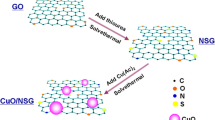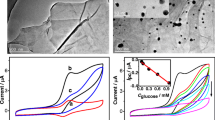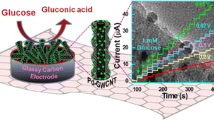Abstract
Glucose oxidase (GOx) was immobilized onto graphene oxide (GRO) via three different preparation methods: enzyme adsorption (EA), enzyme adsorption and crosslinking (EAC), and enzyme adsorption, precipitation and crosslinking (EAPC). EAPC formulations, prepared via enzyme precipitation with 60% ammonium sulfate, showed 1,980 and 1,630 times higher activity per weight of GRO than those of EA and EAC formulations, respectively. After 59 days at room temperature, EAPC maintained 88% of initial activity, while EA and EAC retained 42 and 45% of their initial activities, respectively. These results indicate that the steps of precipitation and crosslinking in the EAPC formulation are critical to achieve high enzyme loading and stability of EAPC. EA, EAC and EAPC were used to prepare enzyme electrodes for use as glucose biosensors. Optimized EAPC electrode showed 93- and 25-fold higher sensitivity than EA and EAC, respectively. To further increase the sensitivity of EAPC electrode, multi-walled carbon nanotubes (MWCNTs) were mixed with EAPC for the preparation of enzyme electrode. Surprisingly, the EAPC electrode with additional 99.5 wt% MWCNTs showed 7,800-fold higher sensitivity than the EAPC electrode without MWCNT addition. Immobilization and stabilization of enzymes on GRO via the EAPC approach can be used for the development of highly sensitive biosensors as well as to achieve high enzyme loading and stability.
Similar content being viewed by others
References
Shao, Y. Y., J. Wang, H. Wu, J. Liu, I. A. Aksay, and Y. H. Lin (2010) Graphene based electrochemical sensors and biosensors: A review. Electroanal. 22: 1027–1036.
Allen, M. J., V. C. Tung, and R. B. Kaner (2010) Honeycomb carbon: A review of graphene. Chem. Rev. 110: 132–145.
Zhu, Y. W., S. Murali, W. W. Cai, X. S. Li, J. W. Suk, J. R. Potts, and R. S. Ruoff (2010) Graphene and graphene oxide: Synthesis, properties, and applications. Adv. Mater. 22: 3906–3924.
Hass, J., W. A. d. Heer, and E. H. Conrad (2008) The growth and morphology of epitaxial multilayer graphene. J. Phys.: Condens. Matter 20: 1–27.
Stoller, M. D., S. Park, Y. Zhu, J. An, and R. S. Ruoff (2008) Graphene-based ultracapacitors. Nano Lett. 8: 3498–3502.
Yoo, E., J. Kim, E. Hosono, H. -S. Zhou, T. Kudo, and I. Honma (2008) Large Reversible Li Storage of graphene nanosheet families for use in rechargeable lithium ion batteries. Nano Lett. 8: 2277–2282.
Yoo, E., T. Okata, T. Akita, M. Kohyama, J. Nakamura, and I. Honma (2009) Enhanced electrocatalytic activity of Pt Subnanoclusters on graphene nanosheet surface. Nano Lett. 9: 2255–2259.
Lu, C. H., H. H. Yang, C. L. Zhu, X. Chen, and G. N. Chen (2009) A graphene platform for sensing biomolecules. Angew. Chem. Int. Ed. 48: 4785–4787.
Chen, H., M. B. Muller, K. J. Gilmore, G. G. Wallace, and D. Li (2008) Mechanically strong, electrically conductive, and biocompatible graphene paper. Adv. Mater. 20: 3557–3561.
Liu, Z., J. T. Robinson, X. Sun, and H. Dai (2008) PEGylated nanographene oxide for delivery of water-insoluble cancer drugs. J. Am. Chem. Soc. 130: 10876–10877.
Carbone, M., L. Gorton, and R. Antiochia (2015) An overview of the latest graphene-based sensors for glucose detection: The effects of graphene defects. Electroanal. 27: 16–31.
Liu, F., Y. Piao, K. S. Choi, and T. S. Seo (2012) Fabrication of free-standing graphene composite films as electrochemical biosensors. Carbon 50: 123–133.
Choi, B. G., H. Park, T. J. Park, M. H. Yang, J. S. Kim, S. Y. Jang, N. S. Heo, S. Y. Lee, J. Kong, and W. H. Hong (2010) Solution chemistry of self-assembled graphene nanohybrids for high-performance flexible biosensors. Acs Nano 4: 2910–2918.
Li, M. G., S. D. Xu, M. Tang, L. Liu, F. Gao, and Y. L. Wang (2011) Direct electrochemistry of horseradish peroxidase on graphene-modified electrode for electrocatalytic reduction towards H2O2. Electrochim. Acta 56: 1144–1149.
Zhang, Q., S. J. Yang, J. Zhang, L. Zhang, P. L. Kang, J. H. Li, J. W. Xu, H. Zhou, and X. M. Song (2011) Fabrication of an electrochemical platform based on the self-assembly of graphene oxide-multiwall carbon nanotube nanocomposite and horseradish peroxidase: Direct electrochemistry and electrocatalysis. Nanotechnol. 22: 1–7.
Qiu, J. D., J. Huang, and R. P. Liang (2011) Nanocomposite film based on graphene oxide for high performance flexible glucose biosensor. Sensor. Actuat. B-Chem. 160: 287–294.
Unnikrishnan, B., S. Palanisamy, and S. -M. Chen (2013) A simple electrochemical approach to fabricate a glucose biosensor based on graphene–glucose oxidase biocomposite. Biosens. Bioelectron. 39: 70–75.
Wang, Z. J., X. Z. Zhou, J. Zhang, F. Boey, and H. Zhang (2009) Direct electrochemical reduction of single-layer graphene oxide and subsequent functionalization with glucose oxidase. J. Phys. Chem. C 113: 14071–14075.
Liu, Y., D. S. Yu, C. Zeng, Z. C. Miao, and L. M. Dai (2010) Biocompatible graphene oxide-based glucose biosensors. Langmuir 26: 6158–6160.
Kim, R. E., S. G. Hong, S. Ha, and J. Kim (2014) Enzyme adsorption, precipitation and crosslinking of glucose oxidase and laccase on polyaniline nanofibers for highly stable enzymatic biofuel cells. Enz Microb. Technol. 66: 35–41.
Kim, J. H., S. G. Hong, H. J. Sun, S. Ha, and J. Kim (2016) Precipitated and chemically-crosslinked laccase over polyaniline nanofiber for high performance phenol sensing. Chemosphere 143: 142–147.
Hong, S. G., H. S. Kim, and J. Kim (2014) Highly stabilized lipase in polyaniline nanofibers for surfactant-mediated esterification of ibuprofen. Langmuir 30: 911–915.
Kim, H., I. Lee, Y. Kwon, B. C. Kim, S. Ha, J. H. Lee, and J. Kim (2011) Immobilization of glucose oxidase into polyaniline nanofiber matrix for biofuel cell applications. Biosens. Bioelectron. 26: 3908–3913.
Bergmeyer, H. U., Gawehn, K., Grassl, M. (1974) Methods of Enzymatic Analysis. Second edn. Academic Press Inc., NY, USA.
Mozhaev, V. V., M. V. Sergeeva, A. B. Belova, and Y. L. Khmelnitsky (1990) Multipoint attachment to a support protects enzyme from inactivation by organic-solvents -alpha-chymotrypsin in aqueous-solutions of alcohols and diols. Biotechnol. Bioeng. 35: 653–659.
Mozhaev, V. V. (1993) Mechanism-based strategies for protein thermostabilization. Trends Biotechnol. 11: 88–95.
Mozhaev, V. V., N. S. Melik-nubarov, M. V. Sergeeva, V. Šikšnis, and K. Martinek (1990) Strategy for stabilizing enzymes part one: Increasing stability of enzymes via their multi-point interaction with a support. Biocatal. 3: 179–187.
Kim, J. H., S. -A. Jun, Y. Kwon, S. Ha, B. -I. Sang, and J. Kim (2015) Enhanced electrochemical sensitivity of enzyme precipitate coating (EPC)-based glucose oxidase biosensors with increased free CNT loadings. Bioelectrochem. 101: 114–119.
Author information
Authors and Affiliations
Corresponding authors
Additional information
These authors contributed equally to this work.
Rights and permissions
About this article
Cite this article
Hong, SG., Kim, J.H., Kim, R.E. et al. Immobilization of glucose oxidase on graphene oxide for highly sensitive biosensors. Biotechnol Bioproc E 21, 573–579 (2016). https://doi.org/10.1007/s12257-016-0373-4
Received:
Accepted:
Published:
Issue Date:
DOI: https://doi.org/10.1007/s12257-016-0373-4




